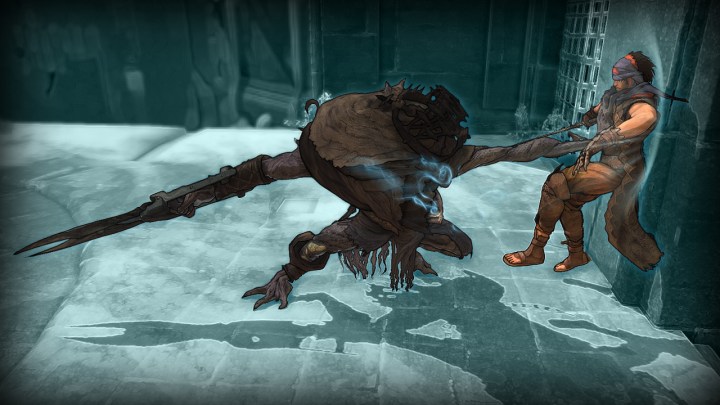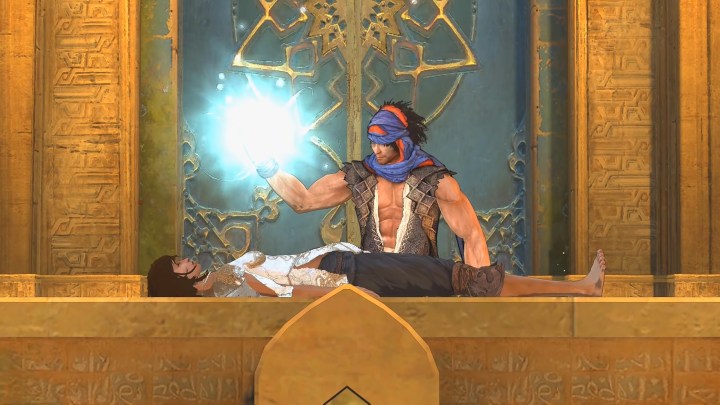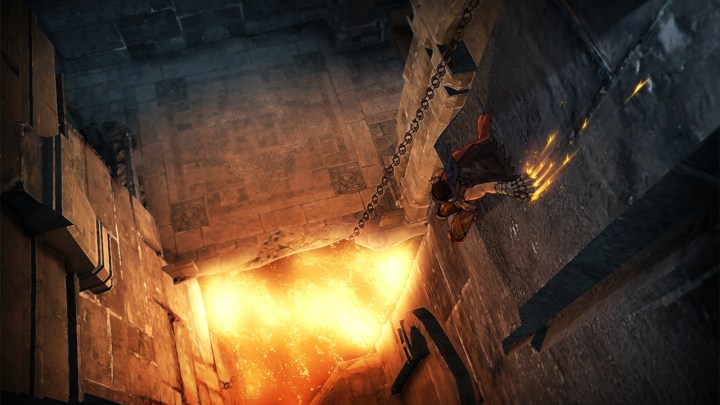
Prince of Persia: The Lost Crown is a fantastic Metroidvania reimagining of the historic series, but it is far from the first reinvention the franchise has seen under Ubisoft. The most iconic one was 2003’s The Sands of Time, which Ubisoft is currently remaking. That’s not the one I decided to play after beating and adoring The Lost Crown, though. That honor goes to 2008’s Prince of Persia.
I spotted Prince of Persia on sale for about $8 a couple of months ago at my local independent game store. I knew nothing about it at the time, outside of the fact that it was a bit controversial for its lack of difficulty and epilogue DLC at the time of release, but I decided to pick it up in case I had the urge to try to play more Prince of Persia after The Lost Crown. I gave it a shot over a long holiday weekend, expecting a dated puzzle platformer that history would have understandably forgotten.
Instead, I discovered a third-person action game that would lay a blueprint that series like The Last of Us, God of War, and Star Wars Jedi would follow. In 2008, Ubisoft Montreal predicted where third-person, narrative-focused action games would go over the next decade. It’s time the studio gets some credit for that.
Spoilers for 2008’s Prince of Persia follow.
Ahead of its time
Prince of Persia begins with the titular character stumbling into a conflict between a daughter and her father. Princess Elika’s father has succumbed to the influence of Ahriman, the god of darkness, and in pursuit of Elika, he destroys the Tree of Life. To prevent Ahriman from being completely set free, the Prince decides to help Elika heal Fertile Grounds around her kingdom so Ahriman can be locked away in the Tree of Life again. It’s a swashbuckling fantasy premise about bad fathers and found family that arrived years before those became more common themes in games.
In some ways, Prince of Persia is also the first Metroidvania game in the series. Players have some freedom in choosing which Fertile Grounds to heal. Along the way, players must collect Light Seeds, which are spent to unlock new powers that enable progress, like what we see in The Lost Crown.
Prince of Persia was released just a year after Uncharted: Drake’s Fortune and Assassin’s Creed, so some climbing and platforming isn’t quite as smooth as in those games, and it features some eccentricities in how controls are mapped. Still, I could see how the emphasis on free-flowing movement had an influence on future games like Respawn Entertainment’s Star Wars Jedi duology. The giant drill fight from Star Wars Jedi: Survivor draws from Prince of Persia’s flight ability. It doesn’t get nearly the same credit as a trailblazer of fluid, somewhat realistic human movement in 3D action games as Assassin’s Creed and Uncharted do, but it’s a fascinating look at a modern third-person action platformer in its nascent stage.

Also ahead of its time is how Elika is incorporated into gameplay. Elika is always with players and can even help out in a fight. This was long before games like The Last of Us and God of War would garner acclaim for similar systems. More importantly, it’s impossible to die in Prince of Persia.
If players miss a jump, Elika will grab them and bring them back to the last platform with stable footing. If the player falls in combat, Elika instantly revives the player, with the only punishment being that the enemy regains some health. This approach to difficulty was derided in 2008; Wired said the game “lost something significant” by including these features. Looking at these mechanics in 2024, this gameplay system feels surprisingly forward-thinking. It makes Prince of Persia a more approachable game, even today. It makes me wish I’d played this hidden gem when it came out, as my younger self would have appreciated its approach to difficulty. Sixteen years later, a Prince of Persia game is once again being lauded for its approach to accessibility, which the gaming industry takes a lot more seriously now.
Combat is the most dated aspect of Prince of Persia. It tries to be very cinematic with simple combos, a lack of fail state, and lots of quick-time events with special camera angles. It suffers from repetition as players are only fighting the same five or so enemies throughout most of the game. If Prince of Persia was made today, I imagine it would draw upon the Souls series’ combat, just as the modern God of War and Star Wars Jedi games have. It represents an era in which 3D action games were attempting to become more engaging and cinematic — an experimental midpoint between Devil May Cry and Demon’s Souls.
The first of us
All those elements already cement Prince of Persia as a hidden gem in my eyes, one that’s worth checking out in 2023. But when I thought the game had no more to give, I was flabbergasted by its ending.

The Prince and Elika grow closer throughout the adventure, and the Prince eventually learns that the King succumbed to Ahriman after Elika died. He revived her, which granted Elika the magical powers she uses to help the Prince and heal Fertile Grounds over the course of the game, but she is now a puppet of Ahriman. The Prince and Elika continue to work together and eventually stop her father, but Elika understands that to restore the Tree of Life, she has to give up her own life and energy to it.
She does so, much to the Prince’s shock and disappointment. Credits roll over gameplay as the Prince slowly carries Elika out of the temple where the final fight occurrs. It’s a moment not too unlike the credits of 2018’s God of War, when Kratos walks back down the mountain on Jotumheim with his son, knowing his death is potentially inevitable. Believing that Ahriman will eventually be freed again in some way as the god is simply trapped and wanting Elika back, the Prince touches the dark side.
In the final post-credits gameplay segment of Prince of Persia, players must cut trees around the temple, draining the life from the land that they spent the whole game restoring. This gives the Prince the power to revive Elika. but unleashes Ahriman upon the world. If that sounds familiar, it may be because The Last of Us was lauded for a similar ending five years later, when Joel murders a group of doctors who could save the world because he does not want to lose Ellie.
For 2008, it’s a subversive and thought-provoking ending, potentially the first of its kind in a mainstream AAA action game like this. It’s not perfectly executed — it doesn’t grapple with the fallout of the Prince’s decision quite as much as The Last of Us did with Joel’s — but Prince of Persia was still bold enough to tackle a heavy theme in that memorable moment.

Considering I did not know about this twist when I booted up the game, I was floored when Prince of Persia wrapped up like this. Why don’t people talk about this ending more? Well, it had a reputation for being unfinished at the time of release. Epilogue DLC was released a few months after launch, offering insight into what happened next to the Prince and Elika. It doesn’t add a ton to the story, and narratively, the base game wraps up in a satisfying way as is. That didn’t dispel the idea that the game ends on a cliffhanger because Ubisoft wanted to draw out the “true ending” in DLC.
Games can get away with building on their endings post-launch nowadays; Baldur’s Gate 3 and Cyberpunk 2077 both did that. It’s another way the video game industry wasn’t quite ready for Prince of Persia in 2008. It garnered solid reviews at release and went on to sell millions of copies, but Prince of Persia does not have the legacy it deserves today.

After a Sands of Time follow-up, called The Forgotten Sands, the series would lay dormant until The Lost Crown’s release on January 18. Ubisoft decided to pursue more Assassin’s Creed-style games rather than continue this rebooted Prince of Persia series. Having not known much about it when I picked it up, I can’t stop thinking about Prince of Persia. I doubt Ubisoft will continue this story, but I don’t think it needs to. Prince of Persia from 2008 and 2024’s The Lost Crown are both proof that the series still has an influential place in the industry and can coexist with the likes of Assassin’s Creed. It’s a series that should not be lost to the sands of time.
Editors' Recommendations
- Prince of Persia is getting a Dead Cells-style roguelike next month
- You can thank Photo Modes for Prince of Persia: The Lost Crown’s best feature
- 5 Switch games you should play while you wait for Prince of Persia: The Lost Crown
- Our most anticipated video games of 2024: Final Fantasy, Hellblade 2, and more
- Prince of Persia: The Lost Crown is big enough to justify its price tag




